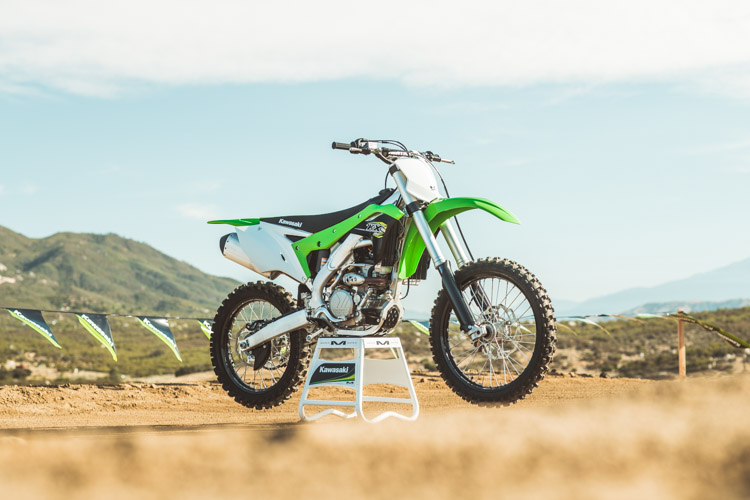 Photos By Drew Ruiz
Photos By Drew Ruiz
Story by Cole Gress and Jimmy Lewis
The Kawasaki KX250F was completely redesigned in 2017 (see link) so 2018 is a revision or update year. So did Kawasaki change enough to keep a champion ready bike? The claims of revised power and torque through the rev range come from using a new throttle body and revised fuel injector angle, altered intake boot with improved flow, a shorter intake funnel. It also gets a new intake camshaft with different timing,a new cylinder head with revised intake tract that includes a partition between the two channels leading towards the valves to keep the air/fuel mixture separate. The piston is changed to boost the compression ratio to 13.4:1. Returning is the second upstream fuel injector that sprays fuel farther back in the intake tract for additional top-end power. The fuel pump has also been updated to put out more pressure as well. On the chassis side Kawasaki looked for a better balance in the suspension with revised settings to the fork by using a lighter spring and different valving in the Showa 48mm SSF fork.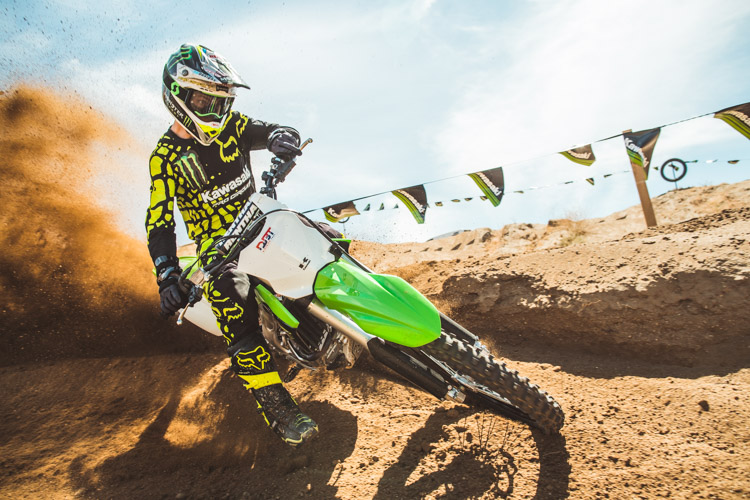
Kawasaki had us out for a full day of riding the new machine at Cahuilla Creek MX. The track is a higher-speed circuit at higher elevation (4,000) with a typically sandy and soft surface. But on this day it was soft top and a hard base which was actually better to feel and evaluate how a bike works. We got to work with technicians to help dial the bike in both suspension and engine tuning with Kawasaki’s KX FI Calibration Controller.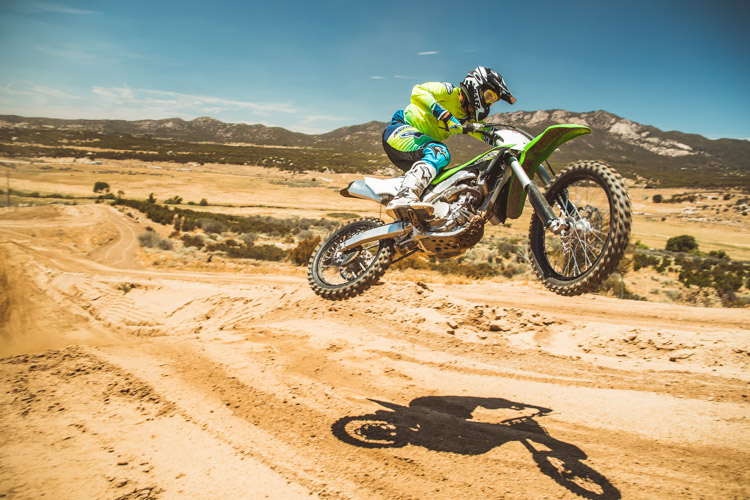 Right from our first laps we were really impressed with the suspension, especially the fork. Suspension is a rider’s friend and this Showa set made the KX suspension your best friend. It was crazy how smooth and and plush it felt. Comparing it to the 2017, which feels stiffer and not as plush, the 2018 has a lighter spring and revised valving which made a big difference. It manages to hold the bike up and balanced without having too stiff of a feel especially for lighter riders.
Right from our first laps we were really impressed with the suspension, especially the fork. Suspension is a rider’s friend and this Showa set made the KX suspension your best friend. It was crazy how smooth and and plush it felt. Comparing it to the 2017, which feels stiffer and not as plush, the 2018 has a lighter spring and revised valving which made a big difference. It manages to hold the bike up and balanced without having too stiff of a feel especially for lighter riders.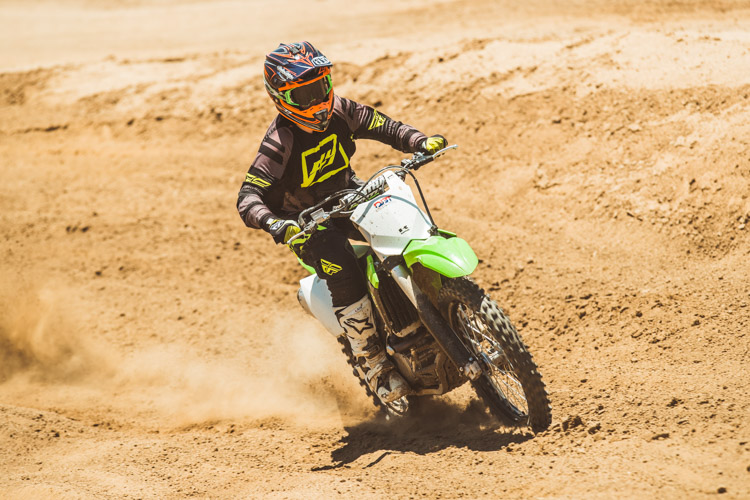 The Showa 48mm Separate Function Front Forks (SSF Spring) locates its damping assembly in the left fork tube and a spring in the right. We felt it was amazing in kicky braking bumps and staying active the whole time. It also resisted bottoming even on downhills and in overjumping. We found sag setting to be pretty critical in making the bike behave and our magic number was 103mm for our test riders. Even our heavy rider (pushing 200 pounds) was able to ride with the stock springs but they were at their limit. Heavier springs will really be needed for riders over 190 to have things working proper. The ’18 KX250F is designed for much lighter riders and Kawasaki really hit the target here. All day long it continued to work as the track got rough without changing clickers which is the sign of a good setup.
The Showa 48mm Separate Function Front Forks (SSF Spring) locates its damping assembly in the left fork tube and a spring in the right. We felt it was amazing in kicky braking bumps and staying active the whole time. It also resisted bottoming even on downhills and in overjumping. We found sag setting to be pretty critical in making the bike behave and our magic number was 103mm for our test riders. Even our heavy rider (pushing 200 pounds) was able to ride with the stock springs but they were at their limit. Heavier springs will really be needed for riders over 190 to have things working proper. The ’18 KX250F is designed for much lighter riders and Kawasaki really hit the target here. All day long it continued to work as the track got rough without changing clickers which is the sign of a good setup.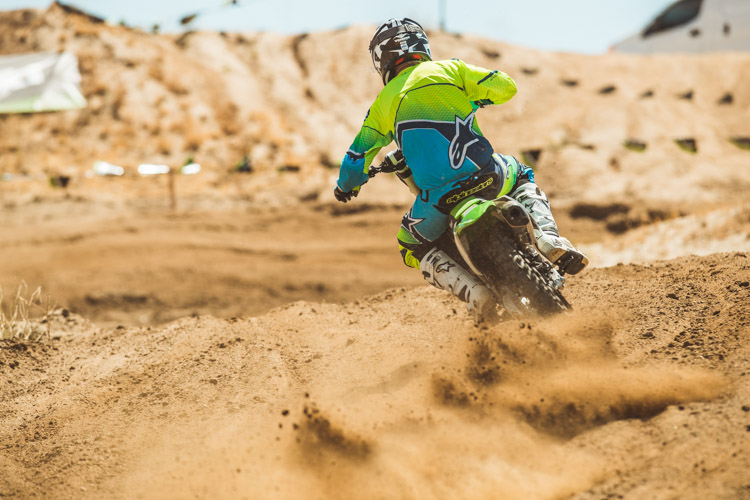
In a class where power is king, Kawasaki has been fighting a battle the last few years with strong competition from Yamaha and KTM. The 2018 the KX is looking at a more robust powerband with increased top end performance. The changes make sense on paper and we confirmed them on the track for the most part. Since this track is at elevation and it is soft, here we never get to feel full power, that will have to wait for our full test. Kawasaki was even proactive with this by having the included accessory white coupler clip installed in the bike right from the get-go during the introduction. Compared to the 2017 KX the 2018 is less choppy in power delivery. It has just a little more torque where it needs it and pulls the gears a little better. It fills in the spots so in actuality it is a little smoother overall–but that has to be explained in the sense that all 250F race bikes are aggressive in nature and need to be ridden with anger. If you are rolling the throttle on and off a lot, the mid-range of the KX is improved but not enough to make a 215 pound man happy.
Compared to the 2017 KX the 2018 is less choppy in power delivery. It has just a little more torque where it needs it and pulls the gears a little better. It fills in the spots so in actuality it is a little smoother overall–but that has to be explained in the sense that all 250F race bikes are aggressive in nature and need to be ridden with anger. If you are rolling the throttle on and off a lot, the mid-range of the KX is improved but not enough to make a 215 pound man happy.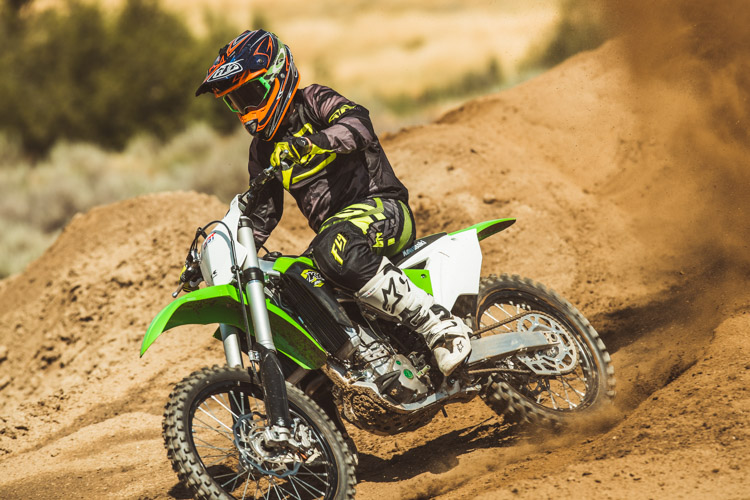
With the white coupler the mapping has a little less fuel so it was a better match for the Cahuilla track. We tried both green (standard, felt lazy and pick-up suffered) and black (richer, needed more rpm for the same amount of power) plug to get a feel for them and the white was definitely more aggressive and responsive. We also felt it ran through the top end power a little quick. Here we played with the KX Calibration Tool and pulled from the vast knowledge Kawasaki has in FI tuning to come up with a map that was personalized for our tastes and the conditions. We’ll be able to get into the specifics with further testing soon.
We were really impressed with the handling of the KX in 2017 and this did not change at all. In fact the front fork improvements have the turning dialed in even more with higher level of confidence and matching improvement in feel. The bike is thin, light and stable, something that no one complained about. We wonder where electric starting is (though the bike starts easily) since it is appearing on other Japanese MX bikes and how the KX stacks up stock-to-stock with the other 2018 machines. Hopefully we’ll have a test bike in our possession soon to do some more comparisons and get a better understanding of the durability and living with the KX. One of our test riders has been riding and racing a 2017 so we have a lot of comparisons to draw from and know a fair amount about its durability. Especially with a teardown looming.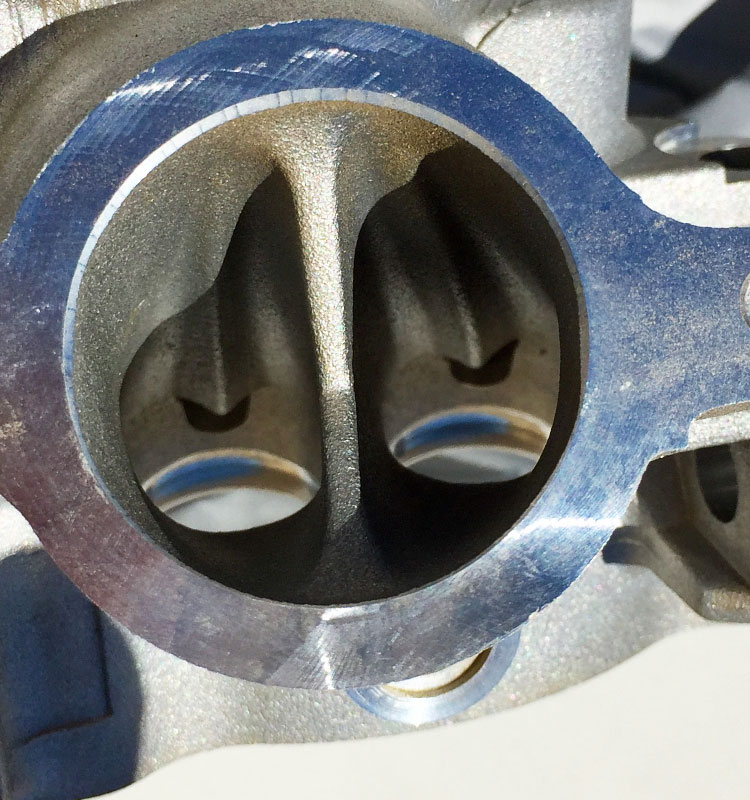 We will say that the 2018 Kawasaki KX250F is an improvement for sure. Mostly small steps but many that have roots developed in trickle-down technology learned from the race teams. Where this KX may really shine is in how some of the improvements will make it easier for amateure racers to modify the bikes into competitive racers without breaking the bank. Kawasaki has a strong contingency program and they are very proud of their Team Green race support program bringing racers through the ranks. All considerations for many potential KX buyers.
We will say that the 2018 Kawasaki KX250F is an improvement for sure. Mostly small steps but many that have roots developed in trickle-down technology learned from the race teams. Where this KX may really shine is in how some of the improvements will make it easier for amateure racers to modify the bikes into competitive racers without breaking the bank. Kawasaki has a strong contingency program and they are very proud of their Team Green race support program bringing racers through the ranks. All considerations for many potential KX buyers.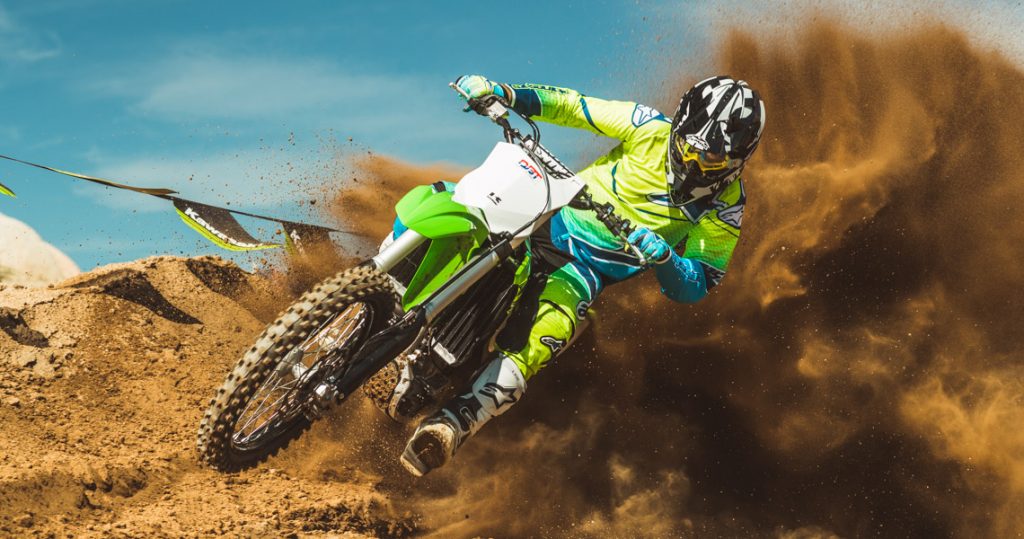
Support this site by shopping through links below:


2 Responses to “2018 Kawasaki KX250F: First Riding Impression”
Richard
Nice review guys. Had a question.
So in comparing 17 to 18, would it be a fair to say that for 18, the suspension changes are much improved but the engine takes on an evolutionary theme for the better?
Jimmy Lewis
Both are improvements, equally in our opinion, engine and suspension. Both are small in the big picture of how much performance they are packing into bikes these days, but a typical increase that can be expected from a manufacturer in yearly increments. Likely stuff they knew would need to be updated last year when the bike was released. Some of the engine stuff will allow and make it easier to make the bike better with modifications, as much as it adds a little beef to the power compared to the 17.